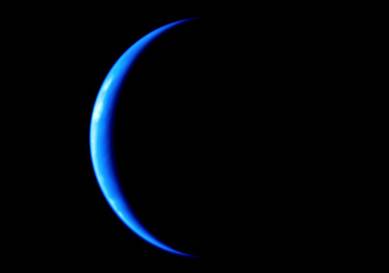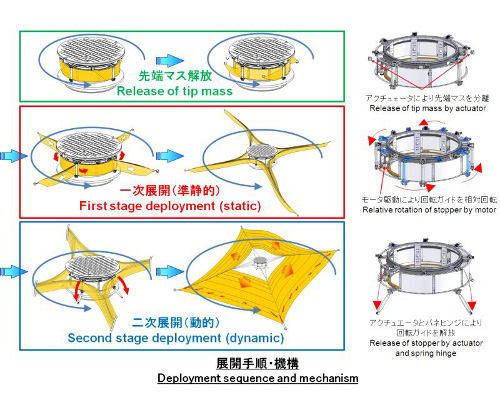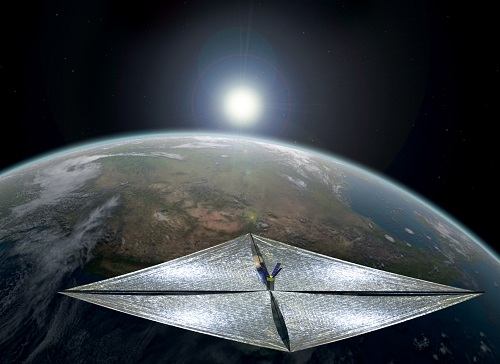
The crescent Earth is lovely in this ultraviolet photo taken by the Japanese Akatsuki probe, now enroute to Venus. The shot was made at a distance of about 250,000 kilometers and keeps me in mind of the IKAROS solar sail demonstrator, which was launched along with Akatsuki and several other payloads on May 20. It’s been tricky keeping up with IKAROS (let’s just say my Japanese is not up to speed, and neither is Google Translate), but a ‘tweet’ from JAXA yesterday said that four cameras aboard the spacecraft had captured images of deployed tip masses, a cause for applause in the IKAROS control room. Photos of that deployment (on May 28) are available on this JAXA site. The sail deployment procedure begins with release of the tip masses and proceeds through stages, as shown below.

Image: Deployment procedure for IKAROS.
We’ll follow IKAROS with great interest as we move toward full sail deployment. Meanwhile, word from Louis Friedman at the Planetary Society is that LightSail-1 is probably not going to be launched until the second quarter of 2011 at the earliest, the delay caused by the need to piggyback aboard an existing mission that can reach the higher orbit the sail requires. The Planetary Society is working with NASA Ames to find launch opportunities.
Suddenly we’re in very interesting times for solar sails, after a long period when the technology seemed ready for testing in space but the opportunity to do so stubbornly failed to emerge. LightSail-1 is the first of three sail missions, with a demonstration of sail technologies to be followed in the second mission by refinements with a larger payload and finally, with LightSail-3, movement into interplanetary space to take on early-warning duties for geomagnetic storms from the Sun. The latter will involve stationing the sail at the Sun-Earth libration point, L1.
LightSail-1 sports a sail area of 32 square meters in the form of four triangular blades. Built around three Cubesat spacecraft, the vehicle will mass less than five kilograms and should offer a lower mass-to-area ratio (and thus higher acceleration from sunlight) than the Society’s Cosmos-1 sail, which was lost in a launch accident in 2005. A recent review by the LightSail project team has resulted in simplication in some aspects of the design, such as using a single-channel radio rather than the planned two-radio system. A critical design review is upcoming, after which the design will be frozen and the team will begin to build the spacecraft.
Hopes are high for LightSail-1 and luck seems to follow the project, as Friedman reports:
…colleagues have a high-sensitivity, commercially developed accelerometer from Lumedyne Technologies they want to test. With LightSail-1, we can supply a flight test, they get the data they need, and we get an advanced set of microminiaturized, high-performance accelerometers for our spacecraft. We’ve just signed an agreement with Millennium Space Systems to that end; the company will provide the software and special processing algorithms to utilize these accelerometers for the LightSail mission.

Image: The Planetary Society’s LightSail-1 will test out solar sail technologies in Earth orbit as a prelude for later missions including solar storm monitoring at L1.
As Friedman says he is committed to the idea of onboard acceleration data, the Lumedyne technology should prove hugely useful in demonstrating the effect of momentum transfer from photons, the basic mechanism for solar sail operations. Friedman told Thomas Mallon in a 2009 Atlantic article that “We’re not trying to be another NASA…but we do show the value of being able to come up with clever things that interest the public, that are scientifically solid.” A successful LightSail-1 will demonstrate the premise, but as to not being another NASA, that may be to Friedman’s advantage. NASA has been working on solar sail technology for a long time now, but a privately funded and built mission will be the next solar sail to fly.



The development of a heavy lift vehicle should make it easy to deploy large light sails at the cislunar Lagrange points. Such sails could be utilized for capturing small NEO asteroids (100 to 200 tonnes in mass) and returning them to the Lagrange points for resource exploitation (hydrogen, oxygen, carbon, nitrogen, platinum, etc.) and for mass shielding spacecraft and space stations from galactic radiation.
Considering the outstanding performance of JAXA’s Kaguya mission http://www.youtube.com/watch?v=EkHuRRDshhg this multiple mission should yield great science.
“Such sails could be utilized for capturing small NEO asteroids (100 to 200 tonnes in mass) and returning them to the Lagrange points”
You’re kidding right?
Nope. Depending on the size and mass of the light sail, potentially thousands of tonnes could be transferred through interplanetary space by a single large light sail:
http://www.aeiveos.com/~bradbury/Authors/Engineering/Drexler-KE/SS.html
http://www.moonminer.com/Solar_sails.html
http://www.stumbleupon.com/su/2Te8Ao/nextbigfuture.com/2008/02/large-sheets-of-carbon-nanotube.html
http://alglobus.net/NASAwork/papers/AsterAnts/paper.html
http://www.youtube.com/watch?v=7Mb47w0vB04 has a sped-up CGI of IKAROS sail deployment.
http://www.jspec.jaxa.jp/ikaros_channel/images/004_003.jpg from the JAXA site shows the centrifugal mass that is seen in the animation.